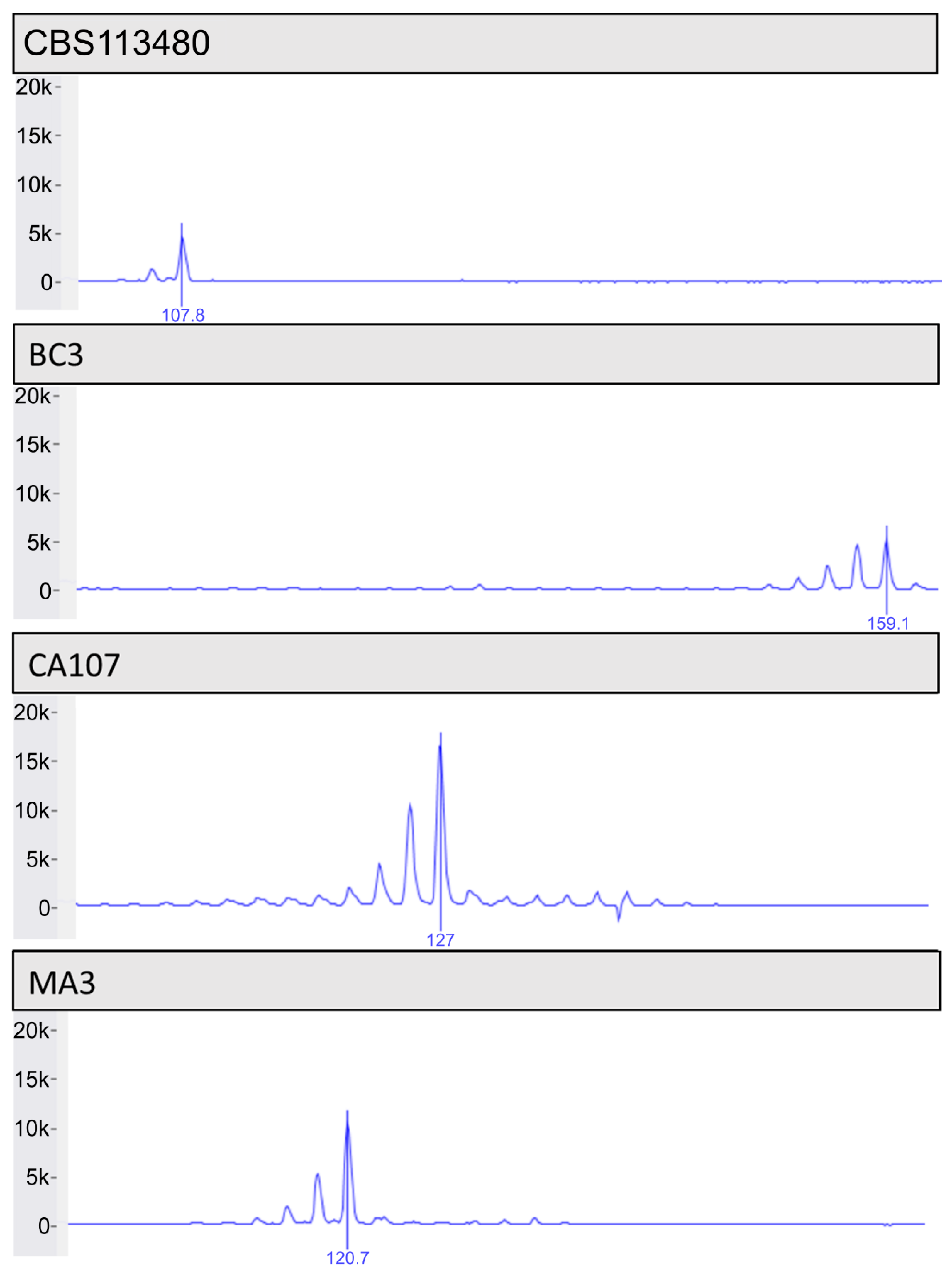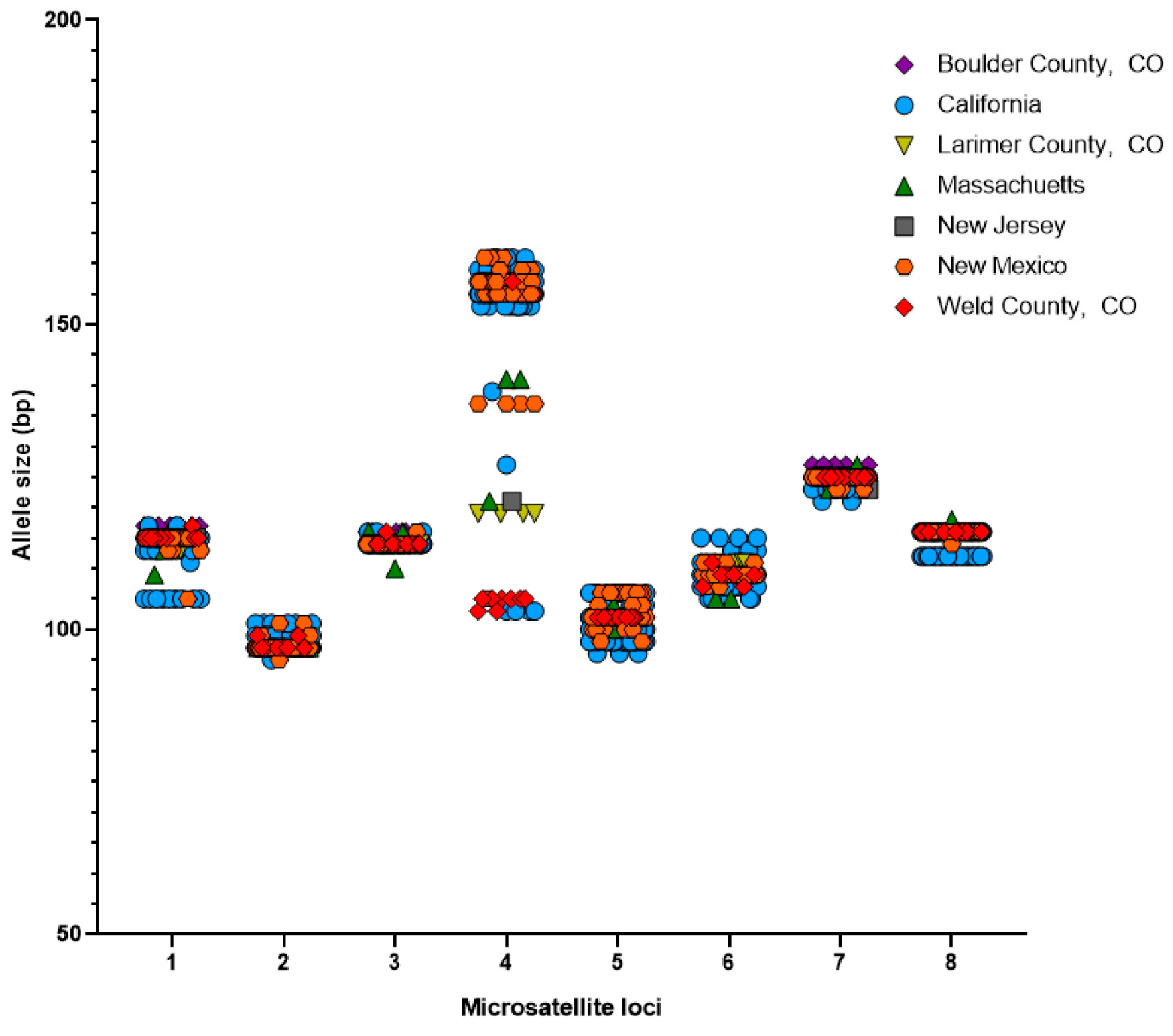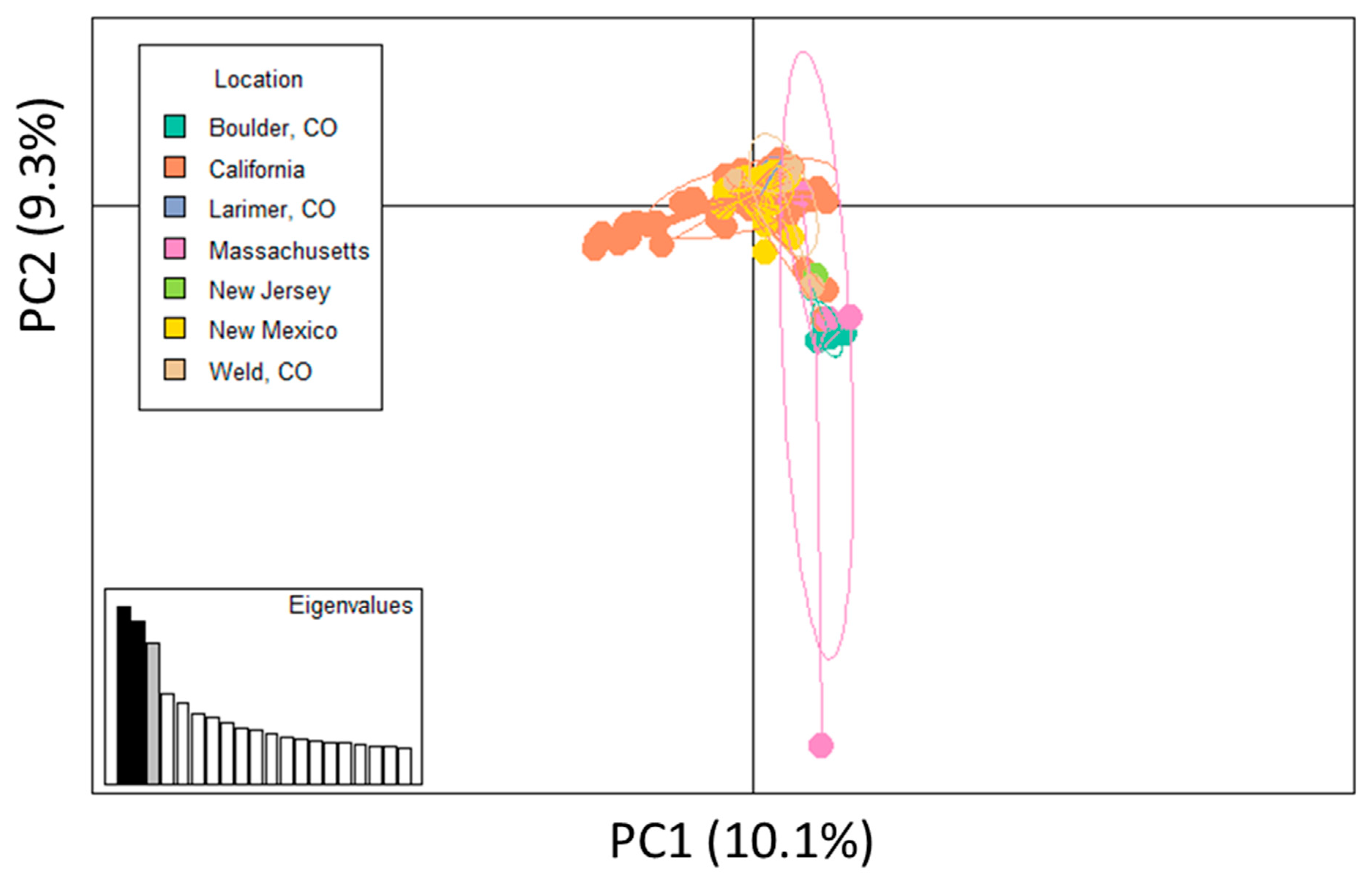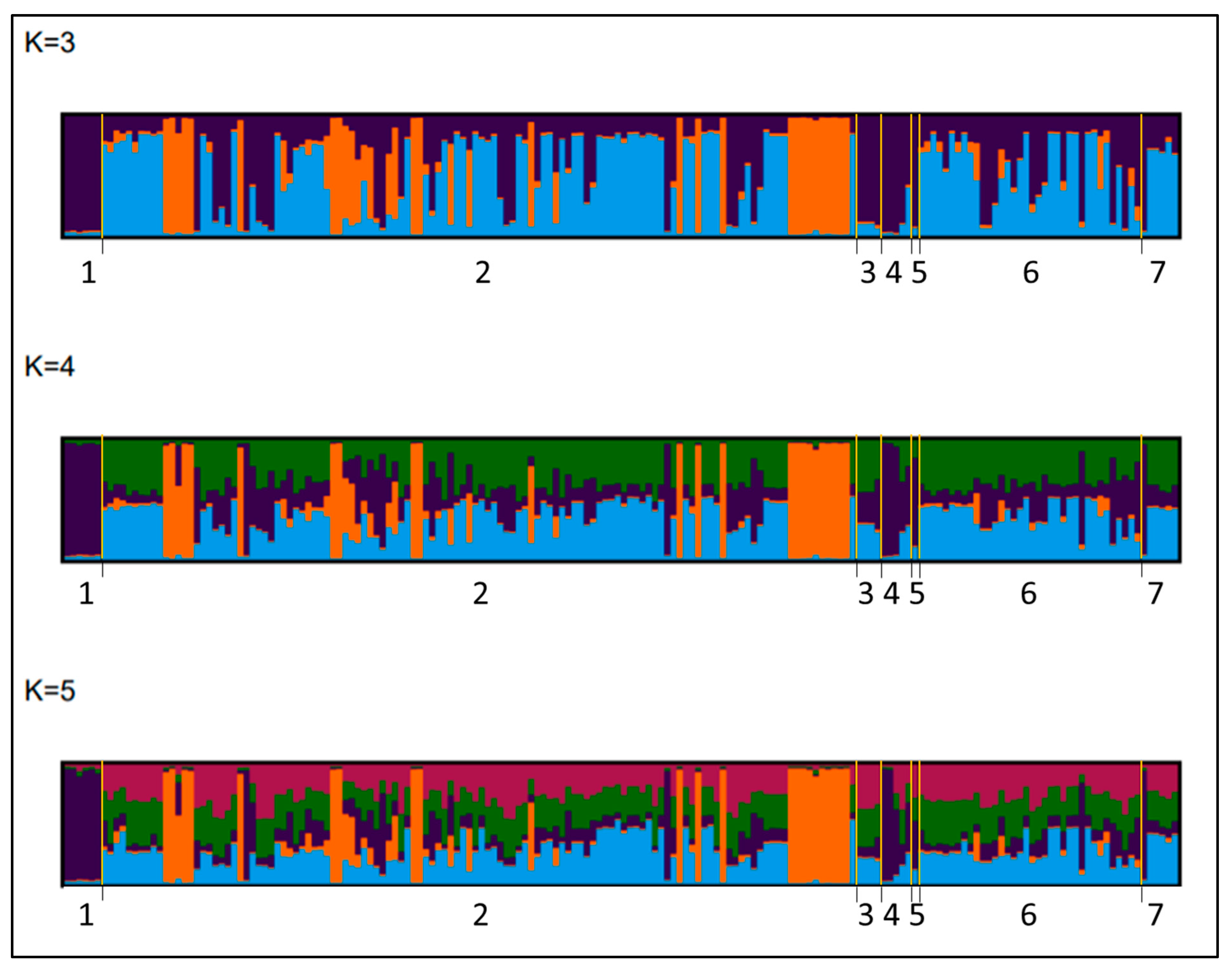Genetic Characterization of Microsporum canis Clinical Isolates in the United States
Abstract
1. Introduction
2. Materials and Methods
2.1. Sample Acquisition
2.2. Clinical Survey
2.3. Reference Fungal Isolate
2.4. Fungal Culture and DNA Extraction
2.5. Dermatophyte Detection and Identification
2.6. Microsatellite PCR
2.7. Microsatellite Analysis
2.8. Statistical Analysis of Genetic Clustering
3. Results
3.1. Majority of Dermatophytosis Cases Are from Stray Intact Kittens with Multiple Alopecic Lesions
3.2. Microsatellite Variation among Samples
3.3. All M. canis Isolates Expressed the MAT1-1 Mating Type Locus
3.4. Homologous Sequences for SSU1 and SUB3 between Isolates
3.5. Clinic Location and Disease Severity Were Associated with Microsatellite Genotype
3.6. Genetic Clustering of M. canis Isolates
4. Discussion
5. Conclusions
Supplementary Materials
Author Contributions
Funding
Institutional Review Board Statement
Informed Consent Statement
Data Availability Statement
Acknowledgments
Conflicts of Interest
References
- Moriello, K. Feline dermatophytosis: Aspects pertinent to disease management in single and multiple cat situations. J. Feline Med. Surg. 2014, 16, 419–431. [Google Scholar] [CrossRef] [PubMed]
- Cafarchia, C.; Romito, D.; Sasanelli, M.; Lia, R.P.; Capelli, G.; Otranto, D. The epidemiology of canine and feline dermatophytoses in southern Italy. Zur Epidemiologie der Dermatophytose von Hund und Katze im Suden Italiens. Mycoses 2004, 47, 508–513. [Google Scholar] [CrossRef] [PubMed]
- Fuller, L.C. Changing face of tinea capitis in Europe. Curr. Opin. Infect. Dis. 2009, 22, 115–118. [Google Scholar] [CrossRef] [PubMed]
- Hay, R.J. Tinea Capitis: Current Status. Mycopathologia 2016, 182, 87–93. [Google Scholar] [CrossRef]
- Ginter-Hanselmayer, G.; Weger, W.; Ilkit, M.; Smolle, J. Epidemiology of tinea capitis in Europe: Current state and changing patterns. Mycoses 2007, 50, 6–13. [Google Scholar] [CrossRef] [PubMed]
- Weitzman, I.; Summerbell, R.C. The dermatophytes. Clin. Microbiol. Rev. 1995, 8, 240–259. [Google Scholar] [CrossRef]
- Mushtaq, S.; Faizi, N.; Amin, S.S.; Adil, M.; Mohtashim, M. Impact on quality of life in patients with dermatophytosis. Australas. J. Dermatol. 2020, 61, e184–e188. [Google Scholar] [CrossRef]
- Frymus, T.; Gruffydd-Jones, T.; Pennisi, M.G.; Addie, D.; Belák, S.; Boucraut-Baralon, C.; Egberink, H.; Hartmann, K.; Hosie, M.J.; Lloret, A.; et al. Dermatophytosis in Cats: ABCD guidelines on prevention and management. J. Feline Med. Surg. 2013, 15, 598–604. [Google Scholar] [CrossRef]
- Newbury, S.; Moriello, K.A. Feline dermatophytosis: Steps for investigation of a suspected shelter outbreak. J. Feline Med. Surg. 2014, 16, 407–418. [Google Scholar] [CrossRef]
- Pasquetti, M.; Peano, A.; Soglia, D.; Min, A.R.M.; Pankewitz, F.; Ohst, T.; Gräser, Y. Development and validation of a microsatellite marker-based method for tracing infections by Microsporum canis. J. Dermatol. Sci. 2013, 70, 123–129. [Google Scholar] [CrossRef]
- Di Pilato, V.; Codda, G.; Ball, L.; Giacobbe, D.R.; Willison, E.; Mikulska, M.; Magnasco, L.; Crea, F.; Vena, A.; Pelosi, P.; et al. Molecular Epidemiological Investigation of a Nosocomial Cluster of C. auris: Evidence of Recent Emergence in Italy and Ease of Transmission during the COVID-19 Pandemic. J. Fungi 2021, 7, 140. [Google Scholar] [CrossRef] [PubMed]
- Etienne, K.A.; Gillece, J.; Hilsabeck, R.; Schupp, J.M.; Colman, R.; Lockhart, S.R.; Gade, L.; Thompson, E.H.; Sutton, D.A.; Neblett-Fanfair, R.; et al. Whole genome sequence typing to investigate the Apophysomyces outbreak following a tornado in Joplin, Missouri, 2011. PLoS ONE 2012, 7, e49989. [Google Scholar] [CrossRef] [PubMed]
- Engelthaler, D.M.; Chiller, T.; Schupp, J.A.; Colvin, J.; Beckstrom-Sternberg, S.M.; Driebe, E.M.; Moses, T.; Tembe, W.; Sinari, S.; Beckstrom-Sternberg, J.S.; et al. Next-generation sequencing of Coccidioides immitis isolated during cluster investigation. Emerg. Infect. Dis. 2011, 17, 227–232. [Google Scholar] [CrossRef] [PubMed]
- Sharma, R.; de Hoog, S.; Presber, W.; Gräser, Y. A virulent genotype of Microsporum canis is responsible for the majority of human infections. J. Med. Microbiol. 2007, 56, 1377–1385. [Google Scholar] [CrossRef] [PubMed]
- da Costa, F.V.A.; Farias, M.R.; Bier, D.; de Andrade, C.P.; de Castro, L.A.; da Silva, S.C.; Ferreiro, L. Genetic variability in Microsporum canis isolated from cats, dogs and humans in Brazil. Mycoses 2013, 56, 582–588. [Google Scholar] [CrossRef]
- Mackenzie, D.W. “Hairbrush Diagnosis” in Detection and Eradication of Non-fluorescent Scalp Ringworm. Br. Med. J. 1963, 2, 363–365. [Google Scholar] [CrossRef]
- Moriello, K.A.; Coyner, K.; Paterson, S.; Mignon, B. Diagnosis and treatment of dermatophytosis in dogs and cats. Vet. Dermatol. 2017, 28, 266-e68. [Google Scholar] [CrossRef]
- Martinez, D.A.; Oliver, B.G.; Gräser, Y.; Goldberg, J.M.; Li, W.; Martinez-Rossi, N.M.; Monod, M.; Shelest, E.; Barton, R.C.; Birch, E.; et al. Comparative genome analysis of Trichophyton rubrum and related dermatophytes reveals candidate genes involved in infection. mBio 2012, 3, e00259-12. [Google Scholar] [CrossRef]
- Brillowska-Dąbrowska, A. DNA Preparation from Nail Samples; W.I.Organization: Copenhagen, Denmark, 2006. [Google Scholar]
- Bergmans, A.M.C.; van der Ent, M.; Klaassen, A.; Böhm, N.; Andriesse, G.I.; Wintermans, R.G.F. Evaluation of a single-tube real-time PCR for detection and identification of 11 dermatophyte species in clinical material. Clin. Microbiol. Infect. 2010, 16, 704–710. [Google Scholar] [CrossRef]
- Kosanke, S.; Hamann, L.; Kupsch, C.; Moreno Garcia, S.; Chopra, A.; Gräser, Y. Unequal distribution of the mating type (MAT) locus idiomorphs in dermatophyte species. Fungal Genet. Biol. 2018, 118, 45–53. [Google Scholar] [CrossRef]
- Li, W.; Metin, B.; White Theodore, C.; Heitman, J. Organization and Evolutionary Trajectory of the Mating Type (MAT) Locus in Dermatophyte and Dimorphic Fungal Pathogens. Eukaryot. Cell 2010, 9, 46–58. [Google Scholar] [CrossRef] [PubMed]
- Descamps, F.; Brouta, F.; Baar, D.; Losson, B.; Mignon, B.; Monod, M.; Zaugg, C. Isolation of a Microsporum canis Gene Family Encoding Three Subtilisin-Like Proteases Expressed in vivo. J. Investig. Dermatol. 2002, 119, 830–835. [Google Scholar] [CrossRef] [PubMed]
- Selkoe, K.A.; Toonen, R.J. Microsatellites for ecologists: A practical guide to using and evaluating microsatellite markers. Ecol. Lett. 2006, 9, 615–629. [Google Scholar] [CrossRef] [PubMed]
- Jombart, T. Adegenet: A R package for the multivariate analysis of genetic markers. Bioinformatics 2008, 24, 1403–1405. [Google Scholar] [CrossRef]
- Jombart, T.; Ahmed, I. adegenet 1.3-1: New tools for the analysis of genome-wide SNP data. Bioinformatics 2011, 27, 3070–3071. [Google Scholar] [CrossRef]
- Legendre; Anderson, M.J. Distance-based redundancy analysis: Testing multispecies responses in Multifactorial Ecological experiments. Ecol. Monogr. 1999, 69, 1–24. [Google Scholar] [CrossRef]
- Oksanen, J.; Blanchet, F.G.; Kindt, R.; Legendre, P.; Minchin, P.; O’Hara, R.B.; Simpson, G.; Solymos, P.; Stevenes, M.H.H.; Wagner, H. Vegan: Community Ecology Package, R package version 2.0-2; R Foundation for Statistical Computing: Vienna, Austria, 2012. [Google Scholar]
- Pritchard, J.K.; Stephens, M.; Donnelly, P. Inference of Population Structure Using Multilocus Genotype Data. Genetics 2000, 155, 945. [Google Scholar] [CrossRef]
- Kopelman, N.M.; Mayzel, J.; Jakobsson, M.; Rosenberg, N.A.; Mayrose, I. Clumpak: A program for identifying clustering modes and packaging population structure inferences across K. Mol. Ecol. Resour. 2015, 15, 1179–1191. [Google Scholar] [CrossRef]
- Evanno, G.; Regnaut, S.; Goudet, J. Detecting the number of clusters of individuals using the software structure: A simulation study. Mol. Ecol. 2005, 14, 2611–2620. [Google Scholar] [CrossRef]
- Viani, F.C.; Cazares Viani, P.R.; Gutierrez Rivera, I.N.; Gonçalves da Silva, E.; Rodrigues Paula, C.; Gambale, W. Extracellular proteolytic activity and molecular analysis of Microsporum canis strains isolated from symptomatic and asymptomatic cats. Rev. Iberoam. De Micol. 2007, 24, 19–23. [Google Scholar] [CrossRef]
- Gräser, Y.; Fröhlich, J.; Presber, W.; de Hoog, S. Microsatellite markers reveal geographic population differentiation in Trichophyton rubrum. J. Med. Microbiol. 2007, 56, 1058–1065. [Google Scholar] [CrossRef] [PubMed]
- Hube, B.; Hay, R.; Brasch, J.; Veraldi, S.; Schaller, M. Dermatomycoses and inflammation: The adaptive balance between growth, damage, and survival. J. De Mycol. Médicale 2015, 25, e44–e58. [Google Scholar] [CrossRef] [PubMed]
- Scott, D.W.; Paradis, M. A survey of canine and feline skin disorders seen in a university practice: Small Animal Clinic, University of Montréal, Saint-Hyacinthe, Québec (1987–1988). Can. Vet. J. 1990, 31, 830–835. [Google Scholar] [PubMed]
- Lewis, D.T.; Foil, C.S.; Hosgood, G. Epidemiology and Clinical Features of Dermatophytosis in Dogs and Cats at Louisiana State University: 1981–1990. Vet. Dermatol. 1991, 2, 53–58. [Google Scholar] [CrossRef]
- Sattasathuchana, P.; Bumrungpun, C.; Thengchaisri, N. Comparison of subclinical dermatophyte infection in short- and long-haired cats. Vet. World 2020, 13, 2798–2805. [Google Scholar] [CrossRef]
- Ewen, K.R.; Bahlo, M.; Treloar, S.A.; Levinson, D.F.; Mowry, B.; Barlow, J.W.; Foote, S.J. Identification and analysis of error types in high-throughput genotyping. Am. J. Hum. Genet. 2000, 67, 727–736. [Google Scholar] [CrossRef]
- Johansson, Å.; Karlsson, P.; Gyllensten, U. A novel method for automatic genotyping of microsatellite markers based on parametric pattern recognition. Hum. Genet. 2003, 113, 316–324. [Google Scholar] [CrossRef]
- Weitzman, I.; Padhye, A.A. Mating behaviour of Nannizzia otae (=Microsporum canis). Mycopathologia 1978, 64, 17–22. [Google Scholar] [CrossRef]
- Rippon, J.W.; Garber, E.D. Dermatophyte Pathogenicity as a Function of Mating Type and Associated Enzymes**From the epartment of Medicine, Section of Dermatology and the Department of Biology, The University of Chicago, Chicago, Illinois 60637. J. Investig. Dermatol. 1969, 53, 445–448. [Google Scholar] [CrossRef][Green Version]
- Hironaga, M.; Nozaki, K.; Watanabe, S. Ascocarp production by Nannizzia otae on keratinous and non-keratinous agar media and mating behavior of N. otae and 123 Japanese isolates of Microsporum canis. Mycopathologia 1980, 72, 135–141. [Google Scholar] [CrossRef]
- de Hoog, G.S.; Dukik, K.; Monod, M.; Packeu, A.; Stubbe, D.; Hendrickx, M.; Kupsch, C.; Stielow, J.B.; Freeke, J.; Göker, M.; et al. Toward a Novel Multilocus Phylogenetic Taxonomy for the Dermatophytes. Mycopathologia 2017, 182, 5–31. [Google Scholar] [CrossRef] [PubMed]
- Léchenne, B.; Reichard, U.; Zaugg, C.; Fratti, M.; Kunert, J.; Boulat, O.; Monod, M. Sulphite efflux pumps in Aspergillus fumigatus and dermatophytes. Microbiology 2007, 153, 905–913. [Google Scholar] [CrossRef] [PubMed]
- Grumbt, M.; Monod, M.; Yamada, T.; Hertweck, C.; Kunert, J.; Staib, P. Keratin Degradation by Dermatophytes Relies on Cysteine Dioxygenase and a Sulfite Efflux Pum. J. Investig. Dermatol. 2013, 133, 1550–1555. [Google Scholar] [CrossRef] [PubMed]
- Baldo, A.; Tabart, J.; Vermout, S.; Mathy, A.; Collard, A.; Losson, B.; Mignon, B. Secreted subtilisins of Microsporum canis are involved in adherence of arthroconidia to feline corneocytes. J. Med. Microbiol. 2008, 57, 1152–1156. [Google Scholar] [CrossRef]
- Mignon, B.; Swinnen, M.; Bouchara, J.P.; Hofinger, M.; Nikkels, A.; Pierard, G.; Gerday, C.H.; Losson, B. Purification and characterization of a 315 kDa keratinolytic subtilisin-like serine protease from and evidence of its secretion in naturally infected cats. Med. Mycol. 1998, 36, 395–404. [Google Scholar] [CrossRef][Green Version]
- Day, M.J. Immune System Development in the Dog and Cat. J. Comp. Pathol. 2007, 137, S10–S15. [Google Scholar] [CrossRef]
- Jartarkar, S.R.; Patil, A.; Goldust, Y.; Cockerell, C.J.; Schwartz, R.A.; Grabbe, S.; Goldust, M. Pathogenesis, Immunology and Management of Dermatophytosis. J. Fungi 2021, 8, 39. [Google Scholar] [CrossRef]
- DeBoer, D.J.; Moriello, K.A. Development of an experimental model of Microsporum canis infection in cats. Vet. Microbiol. 1994, 42, 289–295. [Google Scholar] [CrossRef]
- Wolf, F.T. Chemical nature of the fluorescent pigment produced in Microsporum-infected hair. Nature 1957, 180, 860–861. [Google Scholar] [CrossRef]
- Wolf, F.T.; Jones, E.A.; Nathan, H.A. Fluorescent Pigment of Microsporum. Nature 1958, 182, 475–476. [Google Scholar] [CrossRef]





| Panel | Microsatellite Locus | Orientation | Primer Sequence 5′ to 3′ | Reference |
|---|---|---|---|---|
| 1 | 1 | Forward | [VIC]GAAGGAGGTATATATGGGTGTG | [10] |
| Reverse | GATAAGGTGTTTGGCACTGA | |||
| 4 | Forward | [6-FAM]CAGCATCTAAATAACTGGCCTA | [10] | |
| Reverse | TTTTCTTTCTACTTCCCGTTG | |||
| 5 | Forward | [NED]GGTTTACACGCAGCATGA | [10] | |
| Reverse | CGTGGCTGAAGAAGTCTACC | |||
| 8 | Forward | [PET]GATCGGAGCATGCCATACAG | [14] | |
| Reverse | TCTTCCCACCCTTCTCAATG | |||
| 2 | 2 | Forward | [NED]GGGAACAATCTGCCTTAAAC | [10] |
| Reverse | CACAGAGATATGCCGTATGC | |||
| 3 | Forward | [PET]AGGTGTTTGGCACTGAGC | [10] | |
| Reverse | CGAAGAGAAGGAGGTATATATGG | |||
| 6 | Forward | [6-FAM]CGTCTGGGACTTGGTAGTAA | [10] | |
| Reverse | TCGGAGGATCTTTAAACTGT | |||
| 7 | Forward | [VIC]GCCAAAGAGCTTGCTGAG | [10] | |
| Reverse | CGTTAGCATGCATCTCTCTATAC |
| Sample Categories | CA | NM | BC | LC | WC | MA | NJ | Total |
|---|---|---|---|---|---|---|---|---|
| Samples received | 165 | 53 | 8 | 14 | 8 | 8 | 2 | 258 |
| Culture positive samples | 132 | 42 | 6 | 4 | 6 | 5 | 1 | 191 |
| Samples with clinical data | 139 | 36 | 8 | 14 | 0 | 7 | 2 * | 206 |
| Culture + clinical data | 109 | 31 | 6 | 4 | 0 | 4 | 1 * | 155 |
| Microsatellite samples | 122 | 36 | 6 | 4 | 6 | 5 | 1 | 180 |
| Microsatellite + clinical data | 106 | 26 | 6 | 4 | 0 | 4 | 1 * | 147 |
| Clinical Parameters | Total (n = 154) |
|---|---|
| Sample from shelter or private practice | Shelter (150, 97.4%) |
| Private practice (4, 2.6%) | |
| Age | Kitten (149, 96.8%) |
| Sex | Female (74, 48.1%) |
| Neuter status | Intact (138, 89.6%) |
| Breed | DSH (137, 89%) |
| DMH (11, 7.1%) | |
| DLH (4, 2.6%) | |
| Persian (1, 0.6%) | |
| Exotic Shorthair (1, 0.6%) | |
| Previous housing environment | |
| Stray | 1 (138, 89.6%) |
| Single cat—owned household | 2 (0, 0%) |
| Multi cat—owned household | 3 (3, 1.9%) |
| Previously owned—other animals unknown | 4 (2, 1.3%) |
| Transferred from shelter | 5 (11, 7.1%) |
| Current housing environment | |
| Shelter/rescue—single cat kennel | 1 (40, 26%) |
| Shelter/rescue—multiple cat kennel | 2 (109, 70.8%) |
| Client owned—single cat household | 3 (1, 0.6%) |
| Client owned—multiple cay household | 4 (4, 2.6%) |
| Current medications * | |
| Yes—topical parasite preventatives or dewormer | 1 (32, 20.8%) |
| Yes—oral parasite preventatives or dewormer | 2 (57, 37%) |
| Yes—other | 3 (2, 1.3%) |
| No | 4 (83, 53.9%) |
| Concurrent medical conditions * | URI (28, 18.2%) |
| Ectoparasites (5, 3.2%) | |
| Superficial pyoderma (1, 0.6%) | |
| IBD (1, 0.6%) | |
| Diarrhea (1, 0.6%) | |
| Otitis media (1, 0.6%) | |
| Degloved chin (1, 0.6%) | |
| Underweight (1, 0.6%) | |
| None (114, 74%) | |
| Diagnostics performed * | |
| Wood’s lamp | 1 (151, 98.1%) |
| Fungal culture | 2 (10, 6.5%) |
| IDEXX PCR | 3 (4, 2.6%) |
| Hair observed under microscope | 4 (2, 1.3%) |
| Other | 5 (3, 1.9%) |
| None | 6 (1, 0.6%) |
| If diagnostics have been performed, what were the results? | Wood’s lamp positive (132, 87.4%) |
| Number of lesions | |
| 1 | 1 (29, 18.8%) |
| 2–5 | 2 (67, 43.5%) |
| 5+ | 3 (46, 29.9%) |
| None—no lesions present | 4 (12, 7.8%) |
| Size of lesions | |
| Less than 0.5 inch (smaller than a dime) | 1 (62, 40.2%) |
| Between 0.5 inch and 1 inch (size of a penny) | 2 (59, 38.3%) |
| Greater than 1 inch (larger than a penny) | 3 (21, 13.6%) |
| N/A—no lesions present | 4 (12, 7.8%) |
| Lesion distribution * | |
| Head | 1 (124, 80.5%) |
| Neck | 2 (46, 30%) |
| Abdomen | 3 (46, 30%) |
| Back | 4 (31, 20.1%) |
| Tail including base of tail | 5 (28, 18.2%) |
| Legs including paws | 6 (77, 50%) |
| N/A—no lesions present | 7 (12, 7.8%) |
| Lesion types * | |
| Alopecia | 1 (137, 89%) |
| Scales/crusts | 2 (95, 61.7%) |
| Reddened/erythematous | 3 (9, 5.8%) |
| Papules/pustules | 4 (0, 0%) |
| Miliary dermatitis | 5 (2, 1.3%) |
| N/A—no lesions present | 6 (12, 7.8%) |
| Disease severity | |
| Mild—lesions are small and confined to focal area | 1 (49, 31.8%) |
| Mild to moderate | 2 (20, 13%) |
| Moderate—lesions are found in multiple areas, but is not widespread | 3 (39, 25.3%) |
| Moderate to severe | 4 (14, 9.1%) |
| Severe—lesions are large and found all over the body | 5 (20, 13%) |
| N/A—no lesions present | 6 (12, 7.8%) |
| Microsatellite Locus | Allele Size Range | Most Common Allele (% of Alleles) | % of Missing Genotypes |
|---|---|---|---|
| 1 | 105–117 bp | 115 bp (72%) | 7.2% |
| 2 | 95–101 bp | 97 bp (78%) | 0% |
| 3 | 110–116 bp | 114 bp (79%) | 13% |
| 4 | 103–161 bp | 155 bp (43%) | 1.7% |
| 5 | 96–106 bp | 102 bp (47%) | 0% |
| 6 | 105–115 bp | 109 bp (48%) | 21% |
| 7 | 121–127 bp | 125 bp (81%) | 2.2% |
| 8 | 112–118 bp | 116 bp (79%) | 2.2% |
Publisher’s Note: MDPI stays neutral with regard to jurisdictional claims in published maps and institutional affiliations. |
© 2022 by the authors. Licensee MDPI, Basel, Switzerland. This article is an open access article distributed under the terms and conditions of the Creative Commons Attribution (CC BY) license (https://creativecommons.org/licenses/by/4.0/).
Share and Cite
Moskaluk, A.; Darlington, L.; Kuhn, S.; Behzadi, E.; Gagne, R.B.; Kozakiewicz, C.P.; VandeWoude, S. Genetic Characterization of Microsporum canis Clinical Isolates in the United States. J. Fungi 2022, 8, 676. https://doi.org/10.3390/jof8070676
Moskaluk A, Darlington L, Kuhn S, Behzadi E, Gagne RB, Kozakiewicz CP, VandeWoude S. Genetic Characterization of Microsporum canis Clinical Isolates in the United States. Journal of Fungi. 2022; 8(7):676. https://doi.org/10.3390/jof8070676
Chicago/Turabian StyleMoskaluk, Alex, Lauren Darlington, Sally Kuhn, Elisa Behzadi, Roderick B. Gagne, Christopher P. Kozakiewicz, and Sue VandeWoude. 2022. "Genetic Characterization of Microsporum canis Clinical Isolates in the United States" Journal of Fungi 8, no. 7: 676. https://doi.org/10.3390/jof8070676
APA StyleMoskaluk, A., Darlington, L., Kuhn, S., Behzadi, E., Gagne, R. B., Kozakiewicz, C. P., & VandeWoude, S. (2022). Genetic Characterization of Microsporum canis Clinical Isolates in the United States. Journal of Fungi, 8(7), 676. https://doi.org/10.3390/jof8070676






